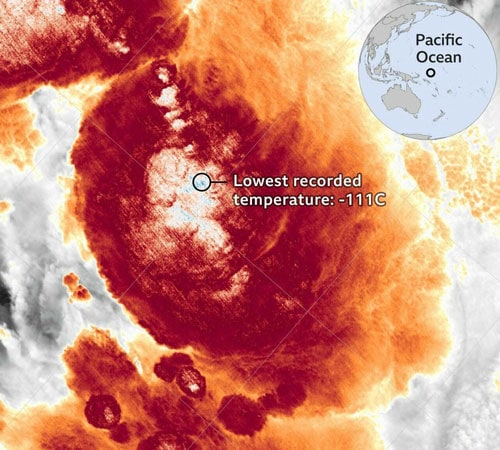London
We’ve all seen those majestic anvil storm clouds that form on a hot summer’s day, but what do you think is the temperature right at the very top?
It’s very cold, obviously; at high altitude it is well below freezing. But would you be surprised to learn it is sometimes below even -100C?
Indeed, scientists have just published research showing the top of one tropical storm cloud system in 2018 reached -111C. This is very likely a record low temperature.
It was seen on 29 December that year, just south of the equator in the western Pacific. The measurement was made by a passing American satellite, Noaa-20.
When a powerful upward draft reaches the top of the lower atmosphere, or troposphere, it will normally flatten and spread out to form that classic anvil shape.
But if the storm is very energetic, the upward movement of air can punch through the troposphere’s ceiling, the tropopause, to keep on rising into the stratosphere, the next layer up in the atmosphere. In the 2018 event, the cloud top was at about 20.5km in altitude.
“It’s called an overshooting top,” explains Dr Simon Proud, a Nerc research fellow in satellite remote sensing at the National Centre for Earth Observation and Oxford University, UK.
“Overshooting tops are reasonably common. We get them over the UK as well, sometimes – like last August when we had a number of massive storms. But this was a very big overshoot.
Normally, an overshooting top cools by about 7C for every kilometre it goes above the tropopause; and this one was about 13C or 14C cooler than the tropopause – so, a pretty big overshoot,” he told BBC News.
Dr Proud and Scott Bachmeier, a research meteorologist at the University of Wisconsin-Madison, US, report the event in a paper in the journal Geophysical Research Letters.
They describe the contributing factors. Although big storms in that part of the Pacific are frequent around the December-January timeframe, this one seemed to get an extra boost.—AP










